西方文化概论课后答案完整版、填空题、名词解释、论述题
西方文化概论试卷及答案(五)

西方文化概论试卷及答案(五)试卷一、名词解释克利特文化孟德斯鸠新古典主义二、论述题1、古典主义艺术的特点是什么2、分析近代初期科学革命产生在欧洲的原因答案试卷五一、名词解释克利特文化:爱琴岛在公元前的3500—前3000年逐渐由新石器文化转入早期青铜文化,公元前2000年,克里特岛建立了以克诺索斯为中心的统一政权,产生了米诺斯文明,其文化明快、平等、温情,是爱琴文化的重要组成部分。
孟德斯鸠:18世纪法国法国伟大的启蒙思想家、法学家,最重要的也是影响最大的著作《论法的精神》发表。
这是一部综合性的政治学著作。
孟德斯鸠反对神学,提倡科学,在洛克分权思想的基础上明确提出了“三权分立”学说;他特别强调法的功能。
新古典主义艺术:18世纪中期,法国兴起了新古典主义艺术流派。
这个流派从表面上看是恢复、保存古代希腊、罗马精神,实际上是追求一种理想主义。
他们模仿古代的典范,许多作品选择古代的题目和主题,以希腊罗马市民英雄主义为作高典范和榜样来塑造人的形象,提倡重大庄严的题材,表现静穆纯洁的内容。
二、论述题1、古典主义艺术的特点是什么拥护王权,颂扬君主,具有鲜明的政治倾向性,强调国家的整体利益而不是个人的利益,主张自我克制而不是个性之上——与人文主义的区别。
拥护王权实际就是坚持国家和民族的统一,王权在当时代表着形成中的民族,具有进步性。
在这个意义上古典主义也是国家主义的同义语崇尚理性和自然,把人性看作是优美的、崇高的的天性,认为它是永恒的的,推崇理性、抑制情感构成了古典主义和人文主义的又一区别。
表现了资产阶级利益和愿望,是对王权的支持与肯定,对蒙昧主义的否定。
但是过分地强调事物的普遍性与规律性,必然回回师事物的个别性和特殊性,导致文学作品的程式化、概念化,使之缺乏情感因素与个性特征。
古典主义把古希腊、罗马文艺理论和创作实践作为效法的楷模,从唯理主义出发,认为文学应该表现出高尚性,永恒性,并把时间当成检验文学价值的标准,强调仿效而不是文学重新,缺乏批判精神的眼光和创造精神。
西方文化概论填空
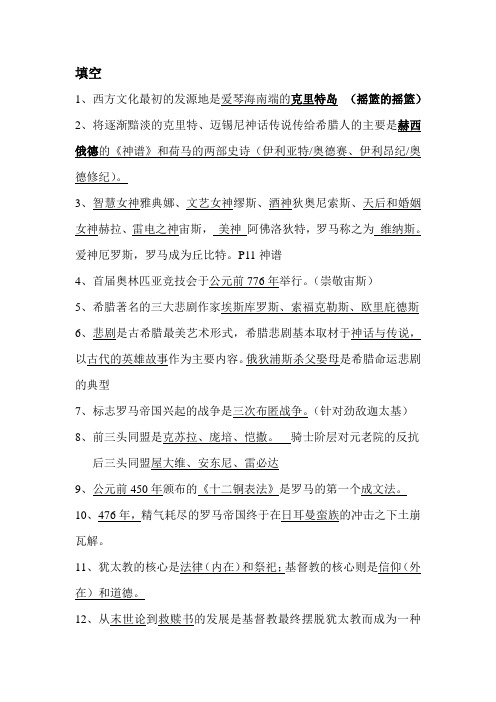
填空1、西方文化最初的发源地是爱琴海南端的克里特岛(摇篮的摇篮)2、将逐渐黯淡的克里特、迈锡尼神话传说传给希腊人的主要是赫西俄德的《神谱》和荷马的两部史诗(伊利亚特/奥德赛、伊利昂纪/奥德修纪)。
3、智慧女神雅典娜、文艺女神缪斯、酒神狄奥尼索斯、天后和婚姻女神赫拉、雷电之神宙斯,美神阿佛洛狄特,罗马称之为维纳斯。
爱神厄罗斯,罗马成为丘比特。
P11神谱4、首届奥林匹亚竞技会于公元前776年举行。
(崇敬宙斯)5、希腊著名的三大悲剧作家埃斯库罗斯、索福克勒斯、欧里庇德斯6、悲剧是古希腊最美艺术形式,希腊悲剧基本取材于神话与传说,以古代的英雄故事作为主要内容。
俄狄浦斯杀父娶母是希腊命运悲剧的典型7、标志罗马帝国兴起的战争是三次布匿战争。
(针对劲敌迦太基)8、前三头同盟是克苏拉、庞培、恺撒。
骑士阶层对元老院的反抗后三头同盟屋大维、安东尼、雷必达9、公元前450年颁布的《十二铜表法》是罗马的第一个成文法。
10、476年,精气耗尽的罗马帝国终于在日耳曼蛮族的冲击之下土崩瓦解。
11、犹太教的核心是法律(内在)和祭祀;基督教的核心则是信仰(外在)和道德。
12、从末世论到救赎书的发展是基督教最终摆脱犹太教而成为一种独立的世界性宗教的重大标志。
13、如果说犹太教为基督教提供了圣教历史的肉身,那么希腊唯心主义哲学为基督教提供了唯灵主义的精神。
14、313年,君士坦丁在米兰与东罗马帝国的皇帝利西尼乌斯共同颁布了就一个敕令,即著名的《米兰敕令》又称《宽容敕令》。
米兰敕令标志着基督教在经受了250年迫害后终于在罗马帝国获得了合法地位。
15、西欧封建社会经济生活的基本单元是“小而全”的庄园16、中世纪西欧的封建制是一种名副其实的封建制,它由“宗主”或“领主”或“封臣”之间的层层分封的金字塔形结构所组成。
17、到了10世纪,修道院已经发展成西欧的最大庄园主,修道院经济基本上控制了整个西欧的经济命脉。
18、1305年腓力推选出法国波尔多大主教继任教皇,即克雷芒五世,随后把教廷从罗马迁至法国飞的阿维农,置于法王的控制之下,自此开始了长达70年之久的“阿维农之囚”。
(完整word版)西方文化概论

西方文化概论克里特文明1【单选题】克里特文明开始突然衰落是从公元前(C)以后。
A、14世纪B、16世纪C、15世纪D、13世纪2【单选题】根据考古发掘,西方文明是起始于(A)左右以前。
A、4500年B、3000年C、4000年D、5000年3【单选题】以下哪一项是西方文明最早的源头?(A)A、克里特岛B、埃及C、罗马D、以上都对4【判断题】爱琴文明不是最早的希腊文明.(×)5【判断题】西方文明的摇篮是希腊文明.(√)迈锡尼文明1【单选题】被称为“英雄时代”,是希腊文明中的(D)。
A、克里特文明时代B、希腊文明时代C、迈锡尼文明时代D、黑暗时代2【单选题】以下关于迈锡尼文明时期,北方入侵的三支浪潮的说法正确的是哪一项?(B)A、第一、二支是暴力入侵B、第一支浪潮是和平渗透C、第一、二支是和平渗透D、第一、三支是暴力入侵3【单选题】按照早到晚顺序将几个希腊文明的阶段进行排序,正确的是(A).A、克里特文明、迈锡尼文明、黑暗时代、希腊文明B、克里特文明、迈锡尼文明、希腊文明、黑暗时代C、迈锡尼文明、克里特文明、希腊文明、黑暗时代D、克里特文明、黑暗时代、迈锡尼文明、希腊文明4【判断题】迈锡尼文明有对克里特文明的借鉴,也有北方粗狂的特点。
(√)5【判断题】希腊土居最早建立了迈锡尼文明。
(×)爱琴神话1【单选题】以下哪一位是最早编撰古希腊神话的神谱的游吟诗人?(D)A、亚里士多德B、荷马C、柏拉图D、赫西俄德2【单选题】集中在(A)的两个半岛的是希腊最主要的文明。
A、南方B、北方C、东方D、西方3【单选题】最早时期,奥运会是一种(A)。
A、祭祀活动B、体育比赛C、筛选官兵的方式D、娱乐活动4【判断题】神兽同形同性是希腊神话中一个显著的特点。
(×)5【判断题】克里特神话包括“阿德涅之线”和“代达罗斯的故事”.(√)赫西俄德与荷马1【单选题】古希腊神话中,大地之神该亚在未经交配的情况下就生下了(D).A、大海之神和动物之神B、天宇之神和星月之神C、动物之神和山河之神D、大海之神和天宇之神2【单选题】荷马和赫西俄德生活在下面哪一时期?(C)A、城邦文明时期B、克里特文明时期C、黑暗时代将尽D、以上都不对3【单选题】认为(A)有血缘关系是希腊神话的特点之一.A、英雄和神B、老百姓和神C、统治者和神D、士兵和神4【判断题】让人关注故事和英雄背后的命运是希腊悲剧的深刻性所在。
尔雅《西方文化概论》部分课后题答案

尔雅《西方文化概论》部分课后题答案本页仅作为文档封面,使用时可以删除This document is for reference only-rar21year.March1.根据考古发掘,西方文明起始于(……)左右以前。
4000年2.克里特文明从公元前()以后就开始突然衰落了。
15世纪3西方文明最早的源头是克里克岛5以下几个希腊文明的阶段,由早到晚顺序正确的是()。
克,迈,黑,希9最早编撰古希腊神话的神谱的游吟诗人是()。
赫西俄德10希腊最主要的文明集中在()的两个半岛。
南方14希腊神话的特点是认为()有血缘关系。
英雄和神17公元前9世纪,()字母传入希腊文明。
腓尼基18希腊城邦文明最鼎盛时期持续的时间是()。
7,8前半叶19被誉为希腊哲学之父的是()。
泰勒斯21下列关于斯巴达和雅典的说法中,正确的是()。
它们都是希腊城邦文化的代表,斯巴达尚武,雅典崇文,斯巴达是寡头政治,雅典是民主制度。
全对22伯里克利当时著名的“丧葬演讲”是为悼念。
伯罗奔尼撒战争23斯巴达最初的法律包括哪三个方面()不是政治,军事,经济25下列关于酒神精神和日神精神的说法中,不正确的是()。
日神是狄奥尼索斯,酒神是阿波罗26古希腊戏剧的诞生与()有关。
酒神29希腊城邦时代,古希腊人受教育的方式主要是()。
观看戏剧30古希腊戏剧的主要内容是()。
古代的神话传说33下列戏剧作品是由索福克勒斯创作的是()。
《俄狄浦斯王》34古希腊戏剧“普罗米修斯三部曲”是()。
《盗火的普罗米修斯》《被缚的普罗米修斯》《解放的普罗米修斯.36亚里士多德认为古希腊的悲剧能调动我们的()情感。
怜悯和敬畏37被誉为古希腊喜剧之父的是()。
阿里斯多芬39在古希腊,米利都学派的创始人,被誉为自然哲学之父的是()苏格拉底40泰勒斯的哲学观点认为()。
万物都是从水中产生,万物又复归于水42西方哲个大数学家也是一个神秘主义倾向的是()。
毕达哥拉斯43恩培多克勒提出的“四根说”认为,任何事物都是()按照不同比例排列组合而成的。
尔雅下半年西方文化概论期末考试答案分
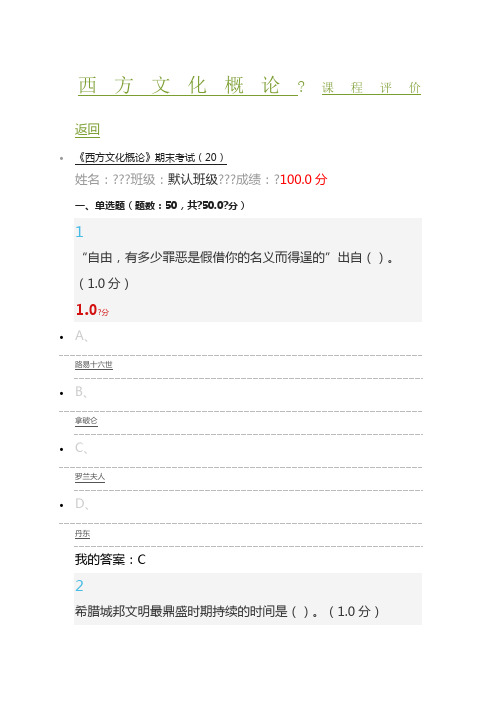
我的答案:C2希腊城邦文明最鼎盛时期持续的时间是()。
(1.0分)我的答案:C7犹太教历史上着名的《出埃及记》讲述的是()率领犹太人逃出了埃及。
(1.0分)我的答案:C12公元1054年,()使希腊和罗马之间的沟壑更加深刻。
(1.0分)1.0?分我的答案:A13()最后导致欧洲中世纪的宗教改革。
(1.0分)1.0?分我的答案:C19下列教堂不属于哥特式的是()。
(1.0分)1.0?分我的答案:B20希腊最主要的文明集中在()的两个半岛。
(1.0分)1.0?分我的答案:D26最早提出上帝头脑中有个罗格斯的人是()。
(1.0分)我的答案:A 33我的答案:C38文艺复兴时期的人文主义特点是()。
(1.0分)1.0?分我的答案:B39最早提出地心说观点的是()。
(1.0分)1.0?分我的答案:D我的答案:B我的答案:D二、判断题(题数:50,共?50.0?分)1再洗礼派盛行于德国、瑞士、荷兰等国的上流阶层。
()(1.0分)1.0?分我的答案:?×2中世纪封建社会时期,老百姓只认领主不清楚自己属于哪个国家。
()(1.0分)1.0?分我的答案:?√3基督教在罗马的传播最初是以上层人民为主。
()(1.0分)1.0?分我的答案:?×4尽管薄伽丘是人文主义者,但他写的《十日谈》却开创了一种民间文学。
()(1.0分)1.0?分我的答案:?√5法国的启蒙运动传到德国后变成了思想的大革命。
()(1.0分)1.0?分我的答案:?√6“阿德涅之线”和“代达罗斯的故事”都属于克里特神话。
()(1.0分)1.0?分我的答案:?√7欧洲文艺复兴运动时期的人文主义者并不反基督教,并使基督教变得更加符合人性。
(1.0分)1.0?分我的答案:?√8希腊人在被罗马人征服的前后都始终瞧不起罗马人,认为他们是一批非常凶悍的乡巴佬。
()(1.0分)1.0?分我的答案:?√9古希腊的悲剧往往产生于好人和坏人之间的冲突,是善恶相争的结果。
西方文化概论详细提纲
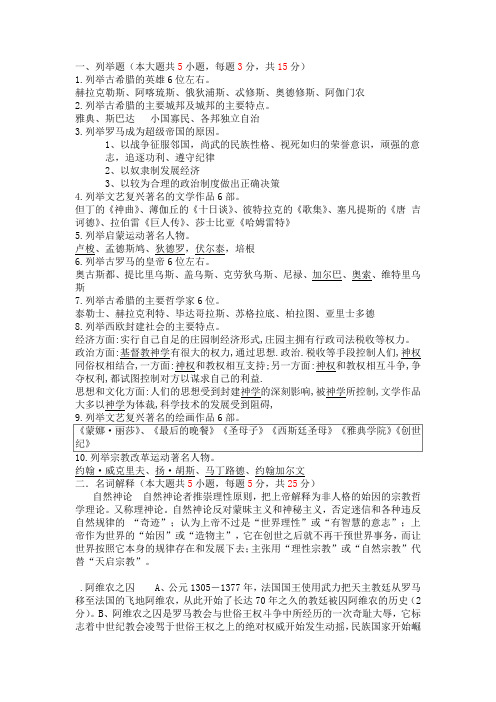
一、列举题(本大题共5小题,每题3分,共15分)1.列举古希腊的英雄6位左右。
赫拉克勒斯、阿喀琉斯、俄狄浦斯、忒修斯、奥德修斯、阿伽门农2.列举古希腊的主要城邦及城邦的主要特点。
雅典、斯巴达小国寡民、各邦独立自治3.列举罗马成为超级帝国的原因。
1、以战争征服邻国,尚武的民族性格、视死如归的荣誉意识,顽强的意志,追逐功利、遵守纪律2、以奴隶制发展经济3、以较为合理的政治制度做出正确决策4.列举文艺复兴著名的文学作品6部。
但丁的《神曲》、薄伽丘的《十日谈》、彼特拉克的《歌集》、塞凡提斯的《唐吉诃德》、拉伯雷《巨人传》、莎士比亚《哈姆雷特》5.列举启蒙运动著名人物。
卢梭、孟德斯鸠、狄德罗,伏尔泰,培根6.列举古罗马的皇帝6位左右。
奥古斯都、提比里乌斯、盖乌斯、克劳狄乌斯、尼禄、加尔巴、奥索、维特里乌斯7.列举古希腊的主要哲学家6位。
泰勒士、赫拉克利特、毕达哥拉斯、苏格拉底、柏拉图、亚里士多德8.列举西欧封建社会的主要特点。
经济方面:实行自己自足的庄园制经济形式,庄园主拥有行政司法税收等权力。
政治方面:基督教神学有很大的权力,通过思想.政治.税收等手段控制人们,神权同俗权相结合,一方面:神权和教权相互支持;另一方面:神权和教权相互斗争,争夺权利,都试图控制对方以谋求自己的利益.思想和文化方面:人们的思想受到封建神学的深刻影响,被神学所控制,文学作品大多以神学为体裁,科学技术的发展受到阻碍,约翰·威克里夫、扬·胡斯、马丁路德、约翰加尔文二.名词解释(本大题共5小题,每题5分,共25分)自然神论自然神论者推崇理性原则,把上帝解释为非人格的始因的宗教哲学理论。
又称理神论。
自然神论反对蒙昧主义和神秘主义,否定迷信和各种违反自然规律的“奇迹”;认为上帝不过是“世界理性”或“有智慧的意志”;上帝作为世界的“始因”或“造物主”,它在创世之后就不再干预世界事务,而让世界按照它本身的规律存在和发展下去;主张用“理性宗教”或“自然宗教”代替“天启宗教”。
西方文化导论课件1-6课后题答案

(1) Give a brief account of the major achievements of Greek culture, such as those in religion, philosophy, literature and science.Greek religion really took shape during the Homeric Age and featured polytheism with gods taking human form and feeling. Greek religion made a great contribution to Greek literature, philosophy and art. It is an important origin of Greek mythology which was fully developed by the religious tales of the Homeric epic and thus affected the later development of all kinds of Greek culture.Greek philosophy started with Thales (640 BC–547 BC) who believed that the material world originated in water. His philosophy was materialism. He was followed by Pythagoras who assumed that the key to the understanding of the world is numbers, on the opposition of the spokesman for idealism.The core Greek philosophers are Socrates, Plato and Aristotle. Socrates had scant regard for material wealth, but was keen on probing into the definition of some ethical and behavioral issues, such as “friendship” and “courage”.Plato established the Academy -the first Greek institution of higher learning. His contributions included his theory of ideas and his arguments on “republic” which was supposed to embrace his ideals about a future state where humans could enjoy a happy life. Aristotle is also a learned man and his work covers wide-ranging areas. His reputation as a philosopher largely depends on his argument on metaphysics which he tried to achieve a compromise between matter and divinity.Literary representation centred round the two epic poems of the Iliad and the Odyssey, lyrical poetry by Sappho and Pindar and drama by Aeschylus, Euripides and Aristophanes. Their works combined Greek myths and social life and won much appreciation and enthusiasm from the public.In science the mathematician Euclid established plane geometry and Archimedes discovered the ratio of radius of a circle and the relationship between the volume and surface of a sphere. (2) What do you think of the influence Greek culture has exerted on Western civilization as a whole? Give examples.Greek culture is often termed the cradle of the Western civilization and has had an enormous impact on Western culture. The specific contributions are found in the areas of philosophy, politics, literature, art, science and architecture.Greek politics was one of the greatest influences on the Western civilization. The Greeks were the first to successfully create a government based on the consensus of the people and thus provided a foundation for Western democracy.The second significant influence was that of philosophy. The Socratic idea about ethics and knowledge helped the Westerners care more for the effect of knowledge and value of morality, both of which give sound guidance to people in the later years to improve and change the world outside themselves, i.e., human society and the natural world.Later generations of Westerners have benefited a lot from Greek culture, such as those in painting, sculpture, architecture, drama, poetry and historical works. Classicism had Greek culture as one of the crucial sources, and this has helped Westerners so much that they ascribed the origin of the Renaissance to it. This changed the intellectual conditions of the later medieval period and opened the way to the modern era in the West.(1) Tell briefly the major characteristics and contributions of Roman culture, as are demonstratedin religion, poetry, history and architecture.In the early period, Roman culture often depended heavily on the introduction and imitation of other cultures, particularly, Greek culture. However, the Romans showed the eclectic aspect in their culture,i.e. Romans did not take in all that they collected from other cultures but modified and developed it according to their own need. Thus Romans created their own powerful culture, laying the foundation for subsequent Western culture in many fields.Before Christianity appeared in Roma, ancient Romans were polytheists. They adopted many cults from other religions, fusing them into their own religion. According to Greek culture and others’ culture, they created their own gods and myth, such as Jupiter, Juno, and Venus, which become subject matter for the artist, writers, and architects in their creative production.In poetry, ancient Rome made brilliant achievements, producing numerous distinguished poets and poems. The poet Virgil’s Aeneid is considered as a model epic in the European literary tradition. He is so famous in poetry that he was modeled for many pastoral writers. For example, Italian poetDante called him his teacher in his masterpiece The Divine Comedy. Horace was not only famous for his poems but his critic. In his Epistles, he advanced many influential principles for creative writing, exerting great influences on later generations. In the 17th century his work was translated into English. Another important poet was Ovid, whose Metamorphosis was translated into English and quoted frequently by many famous writers, such as Chaucer, Shakespeare, Ben Jonson, Shirley and T.S. Eliot.A number of important historians came forth in the ancient Roman period. Polybius created his tremendous works consisting of 40 books, History, which spanned about 500 years. Livy was responsible for the great History of Rome in 142 volumes. His works has always been cited by later statesmen, writers and scholars such as Niccolo Machiavelli and Shakespeare.The architecture of ancient Rome adopted the Greek style for its own purposes, but the Romans also developed a new kind. They were more utilitarian and showed an interest in grandeur and scale. They constructed many public edifices which still existed today and became the famous key point of interest for the world. Romans used the arch, the vault and the dome, and discovered how to make concrete.The Roman culture introduced the Roman realism and realistic style in Western culture in painting and sculpture through modern times. Roman culture nourished emerging Western culture, and even the world culture. Such a splendid culture has greatly enriched cultural heritage of human kind.(2) In what sense do you think Roman culture owed its accomplishments to the benefits obtained from Greek culture? Give examples.It is universally acknowledged that Roman culture learned and inherited a lot from Greek culture. This could be seen in what Roman culture adopted from Greek culture as is demonstrated in religion, philosophy and literature.In religion, we know most of the gods in Roman myths came from Greek legends in terms of function and contribution to their myths. Nevertheless, Rome had its own system of beliefs which had been simple and could hardly compare with the plurality of Greek religion. The parallel arrangement of gods provides accurate evidence to show the similarity of the two religions and Roman wisdom in borrowing fine elements from an external culture is obvious.The same is true of Roman philosophy where we could find examples to demonstrate Greekinfluence on their Roman counterpart. The best example is perhaps Stoicism and Epicureanism, both of which originated from Greece and were further developed and modified in Rome.In literature, Roman men of letters also borrowed a great deal from Greek culture. For example, one could find lots of traces of Greek tragedy in Roman drama. Even in Virgil’s b est known epic Aeneid, we could read of similar story of the hero in his voyage from Troy to Rome, compared to Odysseus, who overcomes many difficulties on his way home though they are certainly set against different backgrounds.All in all, the two cultures are closely linked partly because Greek culture is so illustrious that no one could leave it out without picking up something from it. The Roman people were sufficiently intelligent that they could not refuse to take such an opportunity to learn something when the opportunity was available.(1)How was the Jewish Civilization developed after a tortuous history of split and unification? The major explanation for the development of the Jewish Civilization is its strong cohesiveness and vitality, which supports its unsubmissive and persistent advance by putting up its three spiritual and physical pillars as one of the scholars suggests: “the national identity based on the Jewish cultural tradition, the common belief and values enshrined in Judaism, and the community network centered on the synagogue”.Much of the Jewish culture was safeguarded and well preserved by exiled Jews. Under the guidance of rabbis, they put into effect their Judaist beliefs and what they read of Judaist scriptures. They collected and systematically recomposed the scattered legends and manuscripts into the Torah and the Mishna before they compiled finally the Talmud.The Jewish Civilization had thus progressed with each passing day until the Haskalah Movement came forward in the 18th century,which brought about spiritual awakening and a drastic change of their cultural and social conditions.From then on Jews have begun to become aware of the necessity to liberate themselves from the restrictive laws and acquire new knowledge and modern ideas from the Europeans, which enabled them to secure a position for themselves as a race by keeping pace with the advanced levels of social, economic and cultural developments. Most of the Jews thus received a good education, fully armed with cultural and scientific knowledge and did well in their own position whatever it was though they had not yet established or recovered their own land. Thus they have prepared personnel of various kinds for the revival of their civilization and once that country was founded, they could quickly turn it into a well-developed nation in spite of its small size and small population just as what has happened in Israel in recent decades.(2) Say something about Judaism and the Old Testament?Judaism is one of the earliest monotheistic religions practised today. In the beginning,Judaism was composed of a series of beliefs and practices originating in the Tanakh. It was later further explored and explained in the Talmud and other Judaist scripts. Judaism presents itself as the covenantal relationship between the Children of Israel (later, the Jewish nation) and God. The principles and ethics of Judaism had influenced Christianity and Islam, as well as some non-Abrahamic religions. Many of its texts and traditions are central to other Abrahamic religions and provided the foundation for Western Christianity. Its influence is seen in both secular and ecclesiastical affairs in the Western society, just as the frequent occurrences of classical and Christian cultures via conversations or discussions on different occasions, either public or private, formal or informal.The Old Testament is the Judaist Bible which was a complete document and collection of ancient Hebrew adopted by Christianity as part of the Bible. It was written in Hebrew, including the three parts: Pentateuch,Prophets and Hagiographa and Apocrypha. After the Old Testament was translated into Greek by Jewish scholars,many westerners began to understand Judaism by reading this book. It is not only of religious value but also of literatry value in terms of both subject matter and thematic concerns for the writers to refer to or draw on.(1) Why could Christianity be accepted as the official religion first by the Roman Empire and then by the following kingdoms or empires in Europe?a. For the common people in the empire who were fed up with wars and social turmoil, they needed something to fill up their spiritual vacuum. Christianity could play such a role to pacify and comfort them with love and care more effectively than other organizations or religions.b. It could work together with any secular regimes to offer necessary assistance to control ideologically and intellectually the ordinary people, which was thus welcomed by the kings, emperors or aristocrats.c. The name and influence of Christianity would be a symbol of sacredness and justification, which would help the majority of people to accept the reign of a newly emerging ruler and his followers.d. Christianity is also a kind of culture, which to many people suggests social stability and recovery of an old life style they are accustomed to. Though conservative as well, it could be tolerated because their life and property could thus be secured in the changed circumstances. (2) What are the basic differences between Christianity and Judaism?In spite of the fact that the two religions both derived from Jewish culture, there are some basic differences between them.First are the different images of God. For Judaism, its God Jehovah was representation of Nature as an almighty, omnipotent and omniscient supernatural being. He is expected to provide protection for the Jews who suffered so much in history and help the Jews recover their homeland. In contrast, the Christian God Jesus is both human and divine with the origin of humanity and hence shares with humans various kinds of suffering.Second are the different views of God. Jehovah is viewed with a sort of fear and solemnity since He is like fire or wind which would bring force and harm to the human race while the Christian God is kinder and more helpful, since He personally suffers as a human.Third is the different position each religion holds and hence different contribution each makes. For the early period of Judaism, Jehovah enjoyed every respect and worship from the Jews since Israel was a country of integrity and built up the grand temple for its God. But with the fall of the country, all were destroyed including the temple. They could do nothing about worship but keep their respect secretly in mind for their God. Comparatively Christian worship of Jesus was not allowed in the early days since the religion was illegal and only with the improvement of the situation could the Christian disciples openly demonstrate their worship of Jesus in public. Fourth is that Jehovah was important to Jews only in theory and affected them in spirit occasionally while Christianity became an inseparable part of the secular life of the Westerners. Pope and churches became so powerful that they even tried to seize more political power from the emperors or kings who had to depend sometimes on the Christian church for both spiritual and political support since Christianity could easily exert its influence on the church people and non-church people.(1) What are the major features and achievements of the Renaissance? Give examples.The Renaissance is characterized by seeking ideological emancipation, intellectual freedom and political awareness, based on cultural production and religious reformation. All these were undertaken or unfolded gradually but widely, extending its influences to every corner of Europe, with more and more people getting involved.The achievements were seen principally in six areas, namely, painting, sculpture, poetry, fiction, drama and religious reformation as well as the change in the cultural and intellectual climate. Instances could be located in these areas, such as the huge change of subjects and styles in painting. The medieval painting used to centre on depicting Jesus Christ and other Christian subjects, not only effecting similar and the limited subject matter, but also depicting stylistically facial expressions and manners. The great artists in the Renaissance started to focus on the images with individualistic temperament, highlighting humanity instead of divinity, thus breaking away from the medieval frozen models and linking classicalism with human nature as the centre of their representational work.。
西方文化概论答案

西⽅⽂化概论答案1、在克⾥特岛中央的克诺索斯地区因传说中的⽶诺斯(Minos)国王以及他的那座扑朔迷离⽽得名的⽶诺斯⽂明出现于:2、最初的希腊⼈是在公元前三千年从安纳托利亚的东部和叙利亚的北部迁徙⽽来的蛮族⼈T3、公元前12世纪末的民族⼤迁徙使得来⾃北⽅的印欧语系游牧⼊侵者多利亚⼈进⼊希腊半岛,使爱琴海地区进⼊长达三个多世纪的“⿊暗时代”,也称“英雄时代”。
T4、、“⿊暗时代”末期游吟诗⼈的作品中所反映的故事主要发⽣在:希腊神话主要是地中海神话与北⽅印欧语神话相融合的结果。
T赫西俄德的《神谱》蕴涵者⼀种以“命运”为“看不见的⼿”来实现神系更迭的⾃然进化思想。
T伯罗奔尼撒战争中获胜的是:公元前594年通过法律形式废除债务奴⾪制、设置四百⼈会议和公民陪审法庭的是:德尔菲之所以著名,是因为它有⼀个神庙,这个神庙是拜:城邦这种政治经济⽂化统⼀体最重要的特征是分离主义的政治态度和⾃由主义的⽣活信念。
T雅典的陪审法庭是由多少⼈组成的:6000伯⾥克利担任⼗将军委员会主席达30年之久。
T被称为希腊“悲剧之⽗”的是、“悲剧”(tragdy)⼀词即“⼭⽺歌”,⽽⼭⽺则是酒神狄奥尼索斯的象征和奉献给他的最常见的祭品。
T著名史诗《艾涅阿斯纪》将罗马的起源与荷马史诗中的英雄特洛伊联系在⼀起,它的作者是:罗马的扩张开始的年代是:罗马草创之初,聚集了⼀群奴⾪、逃犯和亡命之徒,李维因此⽽称罗马起源于⼀种“垃圾堆状态”。
T公元前287年通过的《⼗⼆铜表法》,规定特布⾥斯会议(平民会议)的决议⽆须通过元⽼院的批准具有法律效⼒。
F公元前60年,罗马第⼀次出现了由三个掌握军队的⼈缔结的“前三头同盟”,他们是:克拉苏、汉尼拔和凯撒。
F、⾰拉古兄弟改⾰的⼀个重要后果是使新兴的骑⼠阶层在政治上的地位提⾼。
公元前50年,⼀位名叫马克·布鲁图斯的青年与元⽼们共同密谋刺杀了凯撒。
F1、毁灭亚历⼭⼤帝国的最后⼀个孑遗托勒密王国,将埃及并⼊罗马版图的是:2、公元193年,罗马历史上喜爱⾓⽃但被他所豢养的⼀个⾓⽃⼠暗杀⽽死的皇帝是:1、⼩伽图为例捍卫共和国的原则,多次公开揭露了()的野⼼,并为此进⾏了不屈不挠的⽃争:、罗马民族⽂化和民族精神的基本特点是功利主义。
西方文化概论 章节测试答案

西方文化概论章节测试答案爱琴文明与希腊神话传说(一)1下列说法错误的是()。
A、希腊文明表现的是一种和谐之美B、罗马文化倾向于较功利,物质方面发展C、西方现代文明包罗万象D、西方现代文明只发展基督教文化正确答案: D2不属于欧洲伸进地中海的三个半岛的是()。
A、巴尔干半岛B、亚平宁半岛C、克里特半岛D、伊比利亚半岛正确答案: C3埃及第一法老王朝大约出现在()。
A、公元前1500年B、公元前2000年C、公元3100年D、约在公元前3100年正确答案: D4下列说法错误的是()。
A、美索不达米亚文明是已知的最古老的文明B、克里特文明晚于埃及文明C、希腊文明的第一个阶段不是克里特-迈锡尼文明D、克里特文明晚于两河流域文明正确答案: C5十九世纪下下半叶,德国的()考古发掘了克里特文明。
A、莱柯曼B、爱因斯坦C、黑格尔D、施里曼正确答案: D6哪一项不是西方文化的特点?()A、跳跃性B、动荡性C、两极的大跳跃D、平稳、以不变应万变正确答案: D7中世纪出现的基督教文化的特点是()。
A、物质主义B、为灵主义C、纵欲主义的D、关注人间、关注现世的快乐正确答案: B8西方文化发展的跳跃性和动荡性要大于中国。
()正确答案:√9西方文化的源头是基督教文化。
()正确答案:×10希腊文明的源头是克里特文明。
()正确答案:√11克里特文明不受埃及文明影响。
()正确答案:×12西方文明发展的跳跃性和动荡性远远大于东方文明。
()正确答案:√13世界上最古老的文化是中国文化。
()正确答案:×14古代希腊是大希腊,环爱琴海周边的地区的都叫希腊文化区,它不仅仅限于今天的希腊半岛的一个民族国家。
()正确答案:√爱琴文明与希腊神话传说(二)1英国考古学家()发掘了1600块刻有克里特铭文的泥板。
A、达尔文B、温特利森C、伊文思D、荷马正确答案: C2最早的希腊人是()。
A、克里特本土人B、罗马人C、多利亚人D、阿卡亚人正确答案: D3对迈锡尼文明说法错误的是()。
西方文化概论重点整理

西方文化概论重点整理一、名词解释1、荷马史诗:荷马史诗是古希腊长篇叙事诗,包括《伊利亚特》和《奥德赛》,相传为古希腊盲诗人荷马所作。
《伊利亚特》描写希腊人同小亚细亚的特洛伊人战争第十年的故事。
《奥德赛》描写伊萨卡国王、远征洛伊的将领奥德修斯归国途中十年漂泊的故事。
荷马史诗不仅是古代欧洲文学史上的优秀作品,而且是研究公元前11世纪到公元前9世纪古希腊早期历史的珍贵史料。
2、尼西亚公会议:公元313年,罗马皇帝君士坦丁颁布了《米兰敕令》,标志着基督教在罗马帝国中取得了合法地位。
公元325年在他的主持下召开了基督教历史上第一次世界性会议,即尼西亚会议。
会议经过激烈的争辩和皇帝的最终裁决,确定了圣子与圣父本体同一的正统教义,但它并没有从根本上杜绝基督教内部的分歧和分裂。
3、爱琴文明:爱琴文明是希腊及爱琴地区古代文明的总称,是欧洲最早的奴隶制文明,是指爱琴海区域公元前3000后半期—公元前12世纪的出现青铜文化。
爱琴文明包括克里特、迈锡尼两大中心,这一时期,原始氏族制度逐步解体,奴隶制国家随之产生,并创造了灿烂辉煌的文化,成为目前已知的欧洲古文明的渊源。
4、希腊神话:希腊神话是许多不同种族、民族、地区的神话传说相互混杂和历史演化的结果,是口头或文字上一切有关古希腊人的神、英雄、自然和宇宙历史的神话。
希腊神话是古希腊宗教的组成部分之一。
5、赫西俄德的《神谱》:赫西俄德他在《神谱》这首长诗中把民间流传的纷繁凌乱的原始神话缀集为具有内在一致性和连贯性的体系神话,将一幅清晰明白的神族血缘谱系和人间英雄根源呈现于后世人们的眼前。
它具有两方面的重要意义:第一,它通过神系的生殖原则反映了一种朴素的宇宙起源论和自然演化观;第二,它蕴含着一种以自我否定为动力的社会进化思想。
6、希腊悲剧:希腊悲剧基本上取决于神话与传说,以古代的英雄故事作为主要内容。
从剧情上看,希腊悲剧与此前的系统叙事诗所表现的古老家族的不幸遭遇有着直接的渊源关系,反映了那些显贵家族内部的伦理冲突。
西方文化概论答案
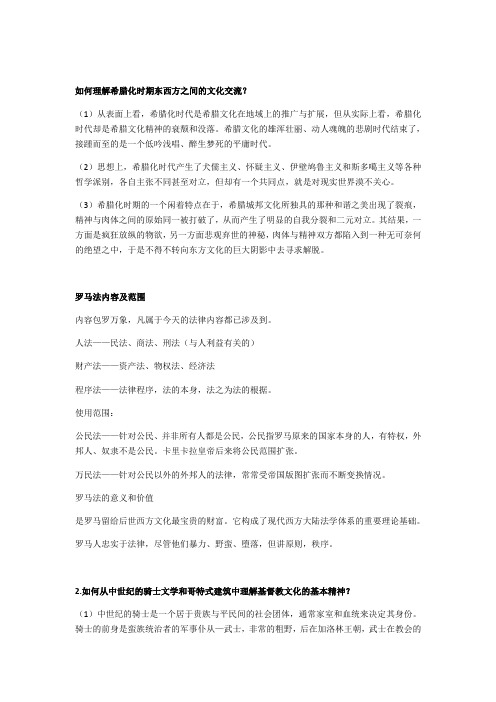
如何理解希腊化时期东西方之间的文化交流?(1)从表面上看,希腊化时代是希腊文化在地域上的推广与扩展,但从实际上看,希腊化时代却是希腊文化精神的衰颓和没落。
希腊文化的雄浑壮丽、动人魂魄的悲剧时代结束了,接踵而至的是一个低吟浅唱、醉生梦死的平庸时代。
(2)思想上,希腊化时代产生了犬儒主义、怀疑主义、伊壁鸠鲁主义和斯多噶主义等各种哲学派别,各自主张不同甚至对立,但却有一个共同点,就是对现实世界漠不关心。
(3)希腊化时期的一个闲着特点在于,希腊城邦文化所独具的那种和谐之美出现了裂痕,精神与肉体之间的原始同一被打破了,从而产生了明显的自我分裂和二元对立。
其结果,一方面是疯狂放纵的物欲,另一方面悲观弃世的神秘,肉体与精神双方都陷入到一种无可奈何的绝望之中,于是不得不转向东方文化的巨大阴影中去寻求解脱。
罗马法内容及范围内容包罗万象,凡属于今天的法律内容都已涉及到。
人法——民法、商法、刑法(与人利益有关的)财产法——资产法、物权法、经济法程序法——法律程序,法的本身,法之为法的根据。
使用范围:公民法——针对公民、并非所有人都是公民,公民指罗马原来的国家本身的人,有特权,外邦人、奴隶不是公民。
卡里卡拉皇帝后来将公民范围扩张。
万民法——针对公民以外的外邦人的法律,常常受帝国版图扩张而不断变换情况。
罗马法的意义和价值是罗马留给后世西方文化最宝贵的财富。
它构成了现代西方大陆法学体系的重要理论基础。
罗马人忠实于法律,尽管他们暴力、野蛮、堕落,但讲原则,秩序。
2.如何从中世纪的骑士文学和哥特式建筑中理解基督教文化的基本精神?(1)中世纪的骑士是一个居于贵族与平民间的社会团体,通常家室和血统来决定其身份。
骑士的前身是蛮族统治者的军事仆从—武士,非常的粗野,后在加洛林王朝,武士在教会的教化下变为日益文雅的骑士。
在基督教的唯灵主义的影响下,在中世纪骑士文学中所表现的那种忠诚、勇敢、高尚、纯洁的骑士精神正好体现了基督教文化的基本精神。
文化概论试题及答案

文化概论试题及答案一、选择题(每题2分,共20分)1. 以下哪项不是文化的基本特征?A. 传承性B. 多样性C. 封闭性D. 普遍性2. 文化的核心是什么?A. 语言B. 宗教C. 价值观D. 艺术3. 以下哪个概念与文化无关?A. 文化认同B. 文化冲突C. 文化适应D. 基因遗传4. 以下哪个选项属于文化的物质层面?A. 风俗习惯B. 语言文字C. 建筑风格D. 宗教信仰5. 跨文化交流中,以下哪项不是常见的障碍?A. 语言差异B. 非语言沟通差异C. 价值观冲突D. 气候差异6. 以下哪个理论不是文化研究的理论?A. 结构主义B. 功能主义C. 后现代主义D. 进化论7. 以下哪个选项是文化相对主义的观点?A. 所有文化都有其固有的优越性B. 某些文化在某些方面优于其他文化C. 文化之间存在优劣之分D. 文化差异是不可逾越的8. 以下哪个不是文化全球化的表现?A. 全球化媒体的普及B. 跨国公司的扩张C. 地方文化的消失D. 国际互联网的发展9. 以下哪个概念是文化适应理论的核心?A. 同化B. 适应C. 排斥D. 抵抗10. 以下哪个选项不是文化传承的方式?A. 教育B. 家庭C. 宗教D. 政治二、简答题(每题10分,共30分)1. 简述文化的功能主义理论的主要观点。
2. 描述跨文化交流中的文化休克现象及其应对策略。
3. 阐述文化相对主义与文化绝对主义的区别。
三、论述题(每题25分,共50分)1. 论述文化多样性对社会发展的意义。
2. 分析全球化背景下的文化冲突与融合,并提出促进文化和谐共存的策略。
参考答案一、选择题1. C2. C3. D4. C5. D6. D7. A8. C9. A10. D二、简答题1. 文化的功能主义理论认为文化是一个整体,其中的各个部分都对整体发挥着功能,维持社会的稳定和秩序。
该理论强调文化的整合作用,认为文化元素之间是相互依赖的。
2. 文化休克是指个体在跨文化交流中由于文化差异而产生的困惑、焦虑和不适应。
西方文化概论任务3附答案
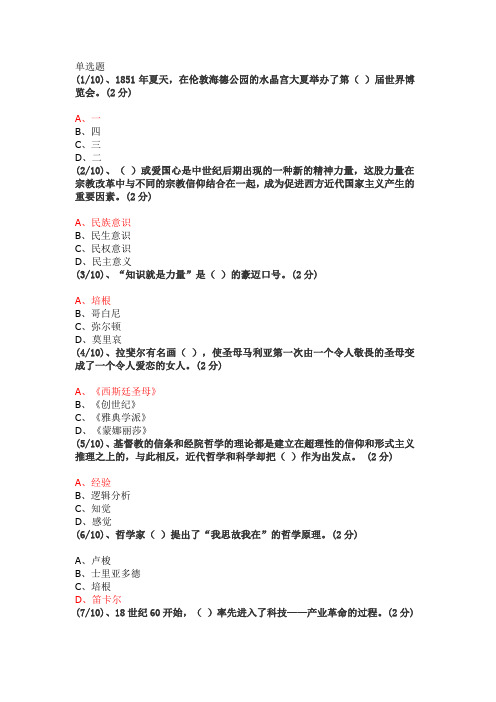
(1/10)、1851年夏天,在伦敦海德公园的水晶宫大夏举办了第()届世界博览会。
(2分)A、一B、四C、三D、二(2/10)、()或爱国心是中世纪后期出现的一种新的精神力量,这股力量在宗教改革中与不同的宗教信仰结合在一起,成为促进西方近代国家主义产生的重要因素。
(2分)A、民族意识B、民生意识C、民权意识D、民主意义(3/10)、“知识就是力量”是()的豪迈口号。
(2分)A、培根B、哥白尼C、弥尔顿D、莫里哀(4/10)、拉斐尔有名画(),使圣母马利亚第一次由一个令人敬畏的圣母变成了一个令人爱恋的女人。
(2分)A、《西斯廷圣母》B、《创世纪》C、《雅典学派》D、《蒙娜丽莎》(5/10)、基督教的信条和经院哲学的理论都是建立在超理性的信仰和形式主义推理之上的,与此相反,近代哲学和科学却把()作为出发点。
(2分)A、经验B、逻辑分析C、知觉D、感觉(6/10)、哲学家()提出了“我思故我在”的哲学原理。
(2分)A、卢梭B、士里亚多德C、培根D、笛卡尔(7/10)、18世纪60开始,()率先进入了科技——产业革命的过程。
(2分)B、美国C、美国D、法国(8/10)、17世纪中后期,西欧各国统治者相信科学技术的发展有利于增长财富和加强国力,纷纷对科学持赞许态度。
在君主们的首肯下,英国皇学学会成为于1662年,法兰西学院成立于()年。
(2分)A、1665B、1668C、1667D、1666(9/10)、()欧洲爆发了第一次世界大战,几十个国家的数亿人口卷入到这场残酷的战争中。
(2分)A、1914年B、1945年C、1941年D、1924年(10/10)、17世纪中叶,宗教宽容精神和政治妥协原则,国内的资本主义经济因素及海外不断发展的商业贸易和殖民扩张,使()逐渐成为欧洲最强盛的资本主义国家和全国殖民体系的“日不落帝国”。
(2分)A、德国B、意大利C、英国D、法国简答题(1/4)、试述加尔文宗教思想与路德宗教思想的区别。
西方文化概论课后答案完整版、填空题、名词解释、论述题

第一章古希腊罗马文化第一节1、如何认识古希腊文明的时间跨度和空间范围?(1)、地域范围:古代希腊的概念是一个大希腊的概念,包括希腊本土、小亚细亚和西亚沿海地区、南意大利地区,甚至伊比利亚半岛和北非。
(2)、时间跨度:古代希腊文化包括三个发展阶段:A、克里特-迈锡尼时代的文化(公元前26-前12世纪)黑暗时代(公元前12-前8世纪)B、希腊城邦时代的文化(公元前8-前4世纪)C、希腊化时代的文化(公元前4-前2世纪)2、赫西俄德的《神谱》具有什么文化学意义?从文化学角度来看,赫西俄德的《神谱》具有两方面的重要意义:第一,它通过神系的生殖原则反映了一种朴素的宇宙起源论和自然演化观;第二,它蕴含着一种自我否定为动力的社会进化思想。
从第一方面来看,希腊神话的神谱不仅仅是神的家族史,同时也反映了希腊人的宇宙生成观,神的衍生和交替也就是自然过程的发生和演进。
这种通过神系的生殖原则来说明宇宙起源和自然演化过程的神话思维图景,构成了哲学和科学产生之前人们唯一的世界观。
从第二方面来看,以内在的自我否定作为神系延续和发展的契机是希腊神话的又一个基本特征。
这种维持神系更新和发展的自我否定机制使希腊神话表现出一种新陈代谢的社会进化思想,而在背后决定着诸神的兴衰泰否的就是那个不出场的“命运”。
这种通过“命运”的“看不见之手”来实现神系更迭和自然进化的思想,构成了希腊神话中最深刻的思想,同时也成为整个西方文化在漫长的历史过程中不断实现自我否定和自我超越的形而上的动力。
第二节1、希腊神话的“神人同形同性”特点反映了什么样的文化精神?第一,反映了对现实生活的珍视,这是希腊宗教和希腊文化的一个显著特点.希腊人的神是人性的神,希腊人的宗教是人性的宗教.使得希腊人带有很强烈的人文主义精神.第二,自然崇拜和感觉主义构成了最基本的特征.自然崇拜主要表现对人的自然形体的崇拜,感觉主义则主要表现对美的事物和现实生活的热爱.第三,”神人同形同性”特点反映了希腊和谐之美的文化精神,这一精神成为西方人心中失落而难以复返的精神家园,滋润着被种种功利要求、上帝呼唤和道德命令折磨得疲惫不堪的灵魂的清纯之泉。
西方文化概论试卷及答案(六)

西方文化概论试卷及答案(六)试卷一、名词解释生命哲学卢梭希腊城邦二、论述题1、分析希腊悲剧的命运和人本思想:2、论述基督教与西方文化的关系答案试卷六一、名词解释生命哲学:又可以叫生活哲学、生的哲学,是19世纪末以来流传西方各国的唯心主义哲学之一。
生命冲动(生命之流)是宇宙万物的真正动力和真实的基础,亦是万物之源。
生命冲动是任意、盲目、偶然发生的过程,无规律性、无因果性,只能通过内心体验或凭直觉去感受它。
人靠直觉认识实在,认识真理,他否定分析和综合方法的认识论作用,甚至也否定概念。
他企图超越唯心和唯物论,建立全新的哲学体系,代表着伯格森。
卢梭:法国伟大的启蒙思想家、哲学家、教育家、文学家,是18世纪法国大革命的思想先驱,主张感觉是认识的来源,坚持“自然神论”的观点;强调人性本善,信仰高于理性。
在社会观上,坚持社会契约论,主张建立资产阶级的“理性王国”;主张自由平等,反对大私有制及其压迫;提出“天赋人权说”,反对专制、暴政。
主要著作有《论人类不平等的起源和基础》、《社会契约论》、《爱弥儿》、《忏悔录》、《新爱洛漪丝》、《植物学通信》等。
希腊城邦:城邦最早诞生在小亚细亚的希腊移民中,目的是为了抵御弗吉亚人、吕底亚人的威胁。
城邦一词源于卫城。
卫城是指与不设防的乡村相对应的有设防的居民点。
起初卫城只是设在山头,人们在遭受敌人攻击或海盗威胁时,就以那里为庇护所。
经过很长的时间,卫城以及周围一片地区才变成经济、政治、宗教和文化中心。
从公元前8世纪,城邦才具有政治意义,成为一种特殊形式的国家组织。
它也是古典时代惟一的国家组织形式。
二、论述题1、分析希腊悲剧的命运和人本思想希腊人认为:命运是不可抗拒的,是不可知的;随着社会发展,三违悲剧家在命运观问题上的看法存在差异,埃斯库罗斯认为命运支配一切,保罗支配神;索福克勒斯认为命运不是具体的神物,而是一种超乎人类之外的抽象的概念,虽不可抗拒,但其正义性和合理性是可以怀疑的,敢于抗争命运的英雄是值得同情和歌颂的。
西方文化概论试卷及答案(二)
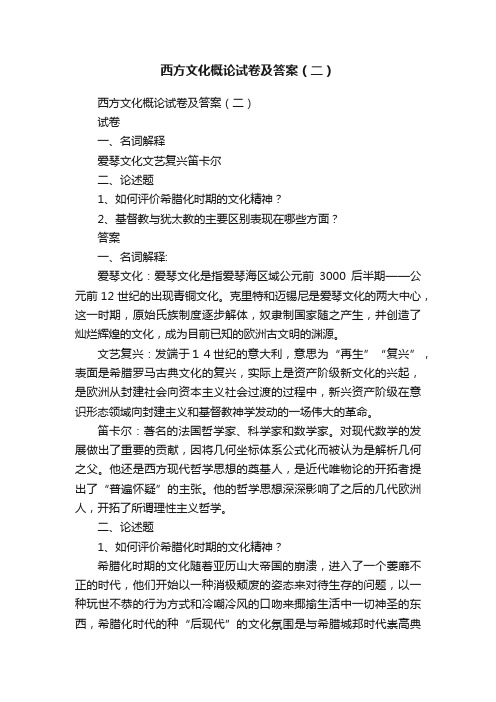
西方文化概论试卷及答案(二)西方文化概论试卷及答案(二)试卷一、名词解释爱琴文化文艺复兴笛卡尔二、论述题1、如何评价希腊化时期的文化精神?2、基督教与犹太教的主要区别表现在哪些方面?答案一、名词解释:爱琴文化:爱琴文化是指爱琴海区域公元前3000后半期——公元前12世纪的出现青铜文化。
克里特和迈锡尼是爱琴文化的两大中心,这一时期,原始氏族制度逐步解体,奴隶制国家随之产生,并创造了灿烂辉煌的文化,成为目前已知的欧洲古文明的渊源。
文艺复兴:发端于14世纪的意大利,意思为“再生”“复兴”,表面是希腊罗马古典文化的复兴,实际上是资产阶级新文化的兴起,是欧洲从封建社会向资本主义社会过渡的过程中,新兴资产阶级在意识形态领域向封建主义和基督教神学发动的一场伟大的革命。
笛卡尔:著名的法国哲学家、科学家和数学家。
对现代数学的发展做出了重要的贡献,因将几何坐标体系公式化而被认为是解析几何之父。
他还是西方现代哲学思想的奠基人,是近代唯物论的开拓者提出了“普遍怀疑”的主张。
他的哲学思想深深影响了之后的几代欧洲人,开拓了所谓理性主义哲学。
二、论述题1、如何评价希腊化时期的文化精神?希腊化时期的文化随着亚历山大帝国的崩溃,进入了一个萎靡不正的时代,他们开始以一种消极颓废的姿态来对待生存的问题,以一种玩世不恭的行为方式和冷嘲冷风的口吻来揶揄生活中一切神圣的东西,希腊化时代的种“后现代”的文化氛围是与希腊城邦时代崇高典雅的悲剧精神背道而驰的。
从表面上看,希腊化时代是希腊文化在地狱上的推广和扩展,但从实质上看,希腊化时代却是希腊文化精神的颓废和没落。
希腊文化的辉雄壮丽、动人魂魄的悲剧时代结束了,接踵而来的是一个低吟浅唱、醉生梦死的平庸时代。
在政治方面,希腊的政治向着东方的专制主义、官僚主义的腐化堕落的方向发展,亚力山大帝国分裂成的三个帝国——希腊的马其顿王国、埃及的托勒密帝国、西亚的塞琉西帝国——陷入了无休无止和徒劳无功的冲突中;希腊的文化则向着繁缛华丽和虚浮无聊的方向发展,越来越多的融入了东方文化骄奢的成分。
西方文化导论课后习题答案_1

西方文化导论课后习题答案(1) Give a brief account of the major achievements of Greek culture, such as those in religion, philosophy, literature and science.Greek religion really took shape during the Homeric Age and featured polytheism with gods taking human form and feeling. Greek religion made a great contribution to Greek literature, philosophy and art. It is an important origin of Greek mythology which was fully developed by the religious tales of the Homeric epic and thus affected the later development of all kinds of Greek culture.Greek philosophy started with Thales (640 BC–547 BC) who believed that the material world originated in water. His philosophy was materialism. He was followed by Pythagoras who assumed that the key to the understanding of the world is numbers, on the opposition of the spokesman for idealism.The core Greek philosophers are Socrates, Plato and Aristotle. Socrates had scant regard for material wealth, but was keen on probing into the definition of some ethical and behavioral issues, such as “friendship”and “courage”.Plato established the Academy -the first Greek institution of higher learning. His contributions included his theory of ideas and his arguments on “republic”which was supposed to embrace his ideals about a future state where humans could enjoy a happy life. Aristotle is also a learned man and his work covers wide-ranging areas. His reputation as a philosopher largely depends on his argument on metaphysics which he tried to achieve a compromise between matter and divinity. Literary representation centred round the two epic poems of the Iliad and the Odyssey, lyrical poetry by Sappho and Pindar and drama by Aeschylus, Euripides and Aristophanes. Their works combined Greek myths andsocial life and won much appreciation and enthusiasm from the public.In science the mathematician Euclid established plane geometry and Archimedes discovered the ratio of radius of a circle and the relationship between the volume and surface of a sphere.(2) What do you think of the influence Greek culture has exerted on Western civilization as a whole? Give examples.Greek culture is often termed the cradle of the Western civilization and has had an enormous impact on Western culture. The specific contributions are found in the areas of philosophy, politics, literature, art, science and architecture.Greek politics was one of the greatest influences on the Western civilization. The Greeks were the first to successfully create a government based on the consensus of the people and thus provided a foundation for Western democracy.The second significant influence was that of philosophy. The Socratic idea about ethics and knowledge helped the Westerners care more for the effect of knowledge and value of morality, both of which give sound guidance to people in the later years to improve and change the world outside themselves, i.e., human society and the natural world.Later generations of Westerners have benefited a lot from Greek culture, such as those in painting, sculpture, architecture, drama, poetry and historical works. Classicism had Greek culture as one of the crucial sources, and this has helped Westerners so much that they ascribed the origin of the Renaissance to it. This changed the intellectual conditions of the later medieval period and opened the way to the modern era in the West.Chapter 21. Tell briefly the major characteristics and contributions of Roman culture, as are demonstrated in religion, poetry, history and architecture.In the early period, Roman culture often depended heavily on the introduction and imitation of other cultures, particularly, Greek culture. Thus Romans created their own powerful culture, laying the foundation for subsequent Western culture in many fields. According to Greek culture and others’ culture; they created their own gods and myth, In poetry, ancient Rome made brilliant achievements,Livy was responsible for the great History of Rome in 142 volumes. His work has always been cited by later statesmen, writers or scholars,The architecture of Ancient Rome adopted the Greek style for its own purposes, but the Romans also developed a new kind.2. In what sense do you think Roman culture owed its accomplishments to the benefits obtained from Greek culture? Give examples.Roman culture learned and inherited a lot from Greekculture.,religion, philosophy and literature. In religion, Rome had its own system of beliefs which had been simple and could hardly compare with the plurality of Greek religion. The same is true of Roman philosophy where we could find examples ,In literature, Roman men of letters also borrowed a All in all, the two cultures are closely linkedgreat deal from Greek culture.Chapter 31. How was the Jewish civilization developed after a tortuous history of split and unification? The major explanation for the development of the Jewish civilization is its strong cohesiveness and vitality,they put into effect their Judaist beliefs and what they read of Judaist scriptures.From then on Jews have begun to become aware of the necessicity to liberate themselves from the restrictive laws and acquire new knowledge and modern ideas from the Europeans, Most of Jews thus received a good education, fully armed with cultural and scientific knowledge and did well in their own position they could quickly turn it into a well developed nation in spite of its small size and small population .2.Say something about Judaism and The Old Testament.The Old Testament is the Judaist Bible. It was written in Hebrew, including the three parts:Pentateuch, Prophets and Hagiographa and Apocrypha. After The Old Testament was translated into Greek by Jewish scholars,many westerners began to understand Judaism by reading this book. It is not only of religious value but also of literatry value.Chapter 41. What are the main components of Christianity and why could it be accepted as the official religion first by the Roman Empire and then by the following kingdoms or empires in Europe?(1)The main components of Christianity are :1) The Bible as the only Christian scripture;Major Christian doctrines about Trinity and Redemption;3) Other doctrines or events of Christianity:(2 )Christianity is accepted and popular in Europe because of these factors:1).For the common people in the empire ,they needed something to fill up their spiritual vacuum. Christianity could play such a role.2). It could work together with any secular regimes to offer necessary assistance.3). The name and influence of Christiaity would be a symbol of sacredness and justification,4) Christianity is also a kind of culture, it could be tolerated because their life and propertycould thus be secured in the changed circumstances.2. What are the basic differences between Christianity and Judaism?In spite of the fact that the two religions derived from Jewish culture, there are some basic differences between them.First is the different image of God.Second is different view of God. Jehovah is viewed He is like fire or wind .God is kinder and more helpful, Third is the different position each religion is located in and hence would make different contribution. Fourth is Jehovah was important to Jews only in theory and affect them in spirit occasionally while Christianity moved into secular life for the Westerner as Pope and churches became very powerful .Chapter 61.Tell simply the background and development of the Renaissance.It was no accident that it first occurred in Florence and Italy where the early signs of capitalism had appeared at the same time as social chaos, political disputes and military clashes , more and more people began to suspect the justification for those who held the power,Painting and sculpture were the first area to reflect the change of subjects and tastes.(2) What are the major features and achievements of the Renaissance? Give examples.The Renaissance is characterised by seeking ideological emancipation, intellectual freedom and political awareness, based on cultural production and religious reformation. All these were undertaken or unfolded gradually but widely, extending its influences to every corner of Europe, with more and more people getting involved.The achievements were seen principally in six areas, namely, painting, sculpture, poetry, fiction, drama and religious reformation as well as the change in the cultural and intellectual climate. Instances could be located in these areas, such as the huge change of subjects and stylesin painting. The medieval painting used to centre on depicting Jesus Christ and other Christian subjects, not only effecting similar and the limited subject matter, but also depicting stylistically facial expressions and manners. The great artists in the Renaissance started to focus on the images with individualistic temperament, highlighting humanity insteadof divinity, thus breaking away from the medieval frozen models and linking classicalism with human nature as the centre of their representational work.文档内容到此结束,欢迎大家下载、修改、丰富并分享给更多有需要的人。
西方文化概论试卷及答案(一)
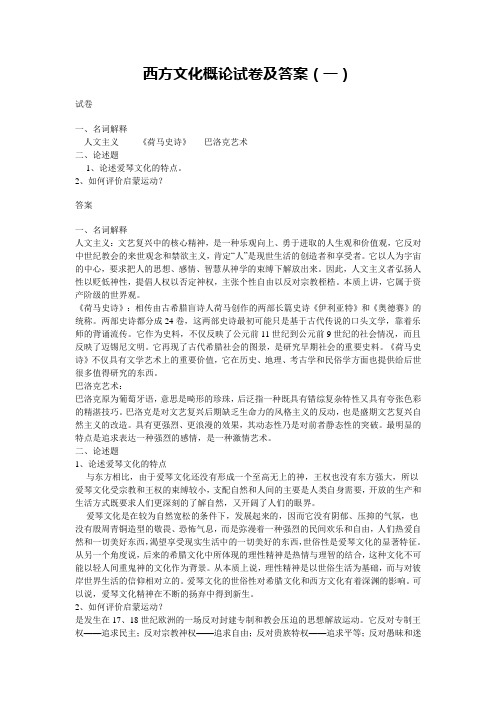
西方文化概论试卷及答案(一)试卷一、名词解释人文主义《荷马史诗》巴洛克艺术二、论述题1、论述爱琴文化的特点。
2、如何评价启蒙运动?答案一、名词解释人文主义:文艺复兴中的核心精神,是一种乐观向上、勇于进取的人生观和价值观,它反对中世纪教会的来世观念和禁欲主义,肯定“人”是现世生活的创造者和享受者。
它以人为宇宙的中心,要求把人的思想、感情、智慧从神学的束缚下解放出来。
因此,人文主义者弘扬人性以贬低神性,提倡人权以否定神权,主张个性自由以反对宗教桎梏。
本质上讲,它属于资产阶级的世界观。
《荷马史诗》:相传由古希腊盲诗人荷马创作的两部长篇史诗《伊利亚特》和《奥德赛》的统称。
两部史诗都分成24卷,这两部史诗最初可能只是基于古代传说的口头文学,靠着乐师的背诵流传。
它作为史料,不仅反映了公元前11世纪到公元前9世纪的社会情况,而且反映了迈锡尼文明。
它再现了古代希腊社会的图景,是研究早期社会的重要史料。
《荷马史诗》不仅具有文学艺术上的重要价值,它在历史、地理、考古学和民俗学方面也提供给后世很多值得研究的东西。
巴洛克艺术:巴洛克原为葡萄牙语,意思是畸形的珍珠,后泛指一种既具有错综复杂特性又具有夸张色彩的精湛技巧。
巴洛克是对文艺复兴后期缺乏生命力的风格主义的反动,也是盛期文艺复兴自然主义的改造。
具有更强烈、更浪漫的效果,其动态性乃是对前者静态性的突破。
最明显的特点是追求表达一种强烈的感情,是一种激情艺术。
二、论述题1、论述爱琴文化的特点与东方相比,由于爱琴文化还没有形成一个至高无上的神,王权也没有东方强大,所以爱琴文化受宗教和王权的束缚较小,支配自然和人间的主要是人类自身需要,开放的生产和生活方式既要求人们更深刻的了解自然,又开阔了人们的眼界。
爱琴文化是在较为自然宽松的条件下,发展起来的,因而它没有阴郁、压抑的气氛,也没有殷周青铜造型的敬畏、恐怖气息,而是弥漫着一种强烈的民间欢乐和自由,人们热爱自然和一切美好东西,渴望享受现实生活中的一切美好的东西,世俗性是爱琴文化的显著特征。
[尔雅]2021年下半年 西方文化概论 课后习题答案
![[尔雅]2021年下半年 西方文化概论 课后习题答案](https://img.taocdn.com/s3/m/5788d0aec67da26925c52cc58bd63186bceb9230.png)
[尔雅]2021年下半年西方文化概论课后习题答案 [尔雅]2021年下半年西方文化概论课后习题答案爱琴文明与希腊神话传说(一)满分:75.0分1【单选】根据考古发掘,西方文明始于()年左右。
a、 3000B,4000C,4500d、5000年我的答案是:B分:0.0分2【单选】公元前()年之后,克里特文明开始突然衰落。
a、公元前16世纪,公元前15世纪,14世纪d、13世纪我的答案是:B分:25.0分3希腊文明被称为西方文明的摇篮。
()我的回答是:√ 得分:25.04最早的希腊文明也被称为爱琴海文明。
()我的回答是:√ 得分:25.0爱琴文明与希腊神话传说(二)已完成成绩:75.0分一【单选题】以下几个希腊文明的阶段,由早到晚顺序正确的是()。
a、克里特文明、迈锡尼文明、希腊文明、黑暗时代b、迈锡尼文明、克里特文明、希腊文明、黑暗时代c、克里特文明、迈锡尼文明、黑暗时代、希腊文明d、克里特文明、黑暗时代、迈锡尼文明、希腊文明我的答案是:C分数:25.02【单选】在迈锡尼文明时期,在三次北方入侵浪潮中,()。
a、第一支浪潮是和平渗透?b、第一、二支是和平渗透?c、第一、二支是暴力入侵?d、第一个和第三个是暴力入侵。
我的答案是:D分数:0.03【真假】迈锡尼文明不仅借鉴了克里特文明,还具有北方粗俗疯狂的特征。
()我的回答是:√ 得分:25.04迈锡尼文明最早是由希腊本地人建立的。
()我的答案:×分数:25.0分爱琴文明与希腊神话传说(三)已完成成绩:75.0分一【单选题】奥运会最早是一种()。
a、运动?b、如何筛选官兵?c、祭祀活动d、娱乐活动我的答案:c得分:25.0分二【单选题】最早编撰古希腊神话的神谱的游吟诗人是()。
a、荷马?b、柏拉图?c、亚里士多德d、赫西奥德我的答案:d得分:25.0分【单选题】希腊最主要的文明集中在()的两个半岛。
a、北方b、东方c、南方d、西部我的答案:d得分:0.0分四【判断题】希腊神话有个显著的特点是神兽同形同性。
- 1、下载文档前请自行甄别文档内容的完整性,平台不提供额外的编辑、内容补充、找答案等附加服务。
- 2、"仅部分预览"的文档,不可在线预览部分如存在完整性等问题,可反馈申请退款(可完整预览的文档不适用该条件!)。
- 3、如文档侵犯您的权益,请联系客服反馈,我们会尽快为您处理(人工客服工作时间:9:00-18:30)。
第一章古希腊罗马文化第一节1、如何认识古希腊文明的时间跨度和空间范围?(1)、地域范围:古代希腊的概念是一个大希腊的概念,包括希腊本土、小亚细亚和西亚沿海地区、南意大利地区,甚至伊比利亚半岛和北非。
(2)、时间跨度:古代希腊文化包括三个发展阶段:A、克里特-迈锡尼时代的文化(公元前26-前12世纪)黑暗时代(公元前12-前8世纪)B、希腊城邦时代的文化(公元前8-前4世纪)C、希腊化时代的文化(公元前4-前2世纪)2、赫西俄德的《神谱》具有什么文化学意义?从文化学角度来看,赫西俄德的《神谱》具有两方面的重要意义:第一,它通过神系的生殖原则反映了一种朴素的宇宙起源论和自然演化观;第二,它蕴含着一种自我否定为动力的社会进化思想。
从第一方面来看,希腊神话的神谱不仅仅是神的家族史,同时也反映了希腊人的宇宙生成观,神的衍生和交替也就是自然过程的发生和演进。
这种通过神系的生殖原则来说明宇宙起源和自然演化过程的神话思维图景,构成了哲学和科学产生之前人们唯一的世界观。
从第二方面来看,以内在的自我否定作为神系延续和发展的契机是希腊神话的又一个基本特征。
这种维持神系更新和发展的自我否定机制使希腊神话表现出一种新陈代谢的社会进化思想,而在背后决定着诸神的兴衰泰否的就是那个不出场的“命运”。
这种通过“命运”的“看不见之手”来实现神系更迭和自然进化的思想,构成了希腊神话中最深刻的思想,同时也成为整个西方文化在漫长的历史过程中不断实现自我否定和自我超越的形而上的动力。
第二节1、希腊神话的“神人同形同性”特点反映了什么样的文化精神?第一,反映了对现实生活的珍视,这是希腊宗教和希腊文化的一个显著特点.希腊人的神是人性的神,希腊人的宗教是人性的宗教.使得希腊人带有很强烈的人文主义精神.第二,自然崇拜和感觉主义构成了最基本的特征.自然崇拜主要表现对人的自然形体的崇拜,感觉主义则主要表现对美的事物和现实生活的热爱.第三,”神人同形同性”特点反映了希腊和谐之美的文化精神,这一精神成为西方人心中失落而难以复返的精神家园,滋润着被种种功利要求、上帝呼唤和道德命令折磨得疲惫不堪的灵魂的清纯之泉。
A:神人同形——希腊人的自然崇拜和感觉主义,崇尚完美的形体。
B:神人同性——神与人一样具有七情六欲、喜怒哀乐,像人一样会犯错,经常到人间来滋生是非、拈花惹草。
由此导致了希腊神话和整个希腊文化的和谐之美的基本特点。
在希腊宗教和希腊文化中,自然崇拜和感觉主义构成了最基本的特征。
肉体与精神的原始和谐,使整个希腊文化呈现出一种田园诗般纯净悠扬的意境。
以人为神的形象,以人的精神承认为神,这是古希腊有别于其它民族发端文化中心的一个不可忽视的特点。
随着希腊神话的形成,形成了最初的希腊人本主义观念它成为整个希腊文明和灵魂,乃至整个西方文明的精神。
2.希腊悲剧中的命运意象首先,希腊悲剧不是善与恶这两种对立的自由意志,而是自由意志与潜藏在它背后的决定论;不是一个人对另一个人的否定,而是自己对自己的否定。
其次,“命运”作为感性的现象世界背后的一种抽象的本质或规律,作为一种普遍性的东西,是建立在形象思维基础之上的希腊神话和悲剧所无法真正把握的,因而对于希腊人来说是一种不可理解也无法改变的宿命。
其次,希腊悲剧表现了一种庄严而神圣的“命运”主题,他的基调是悲壮的、崇高的,因而“命运”是不可亵渎的神圣的。
但这种对“命运”的敬畏被日益兴起的怀疑主义思想所冲淡。
怀疑主义渐渐使悲剧的根源被归结为人性的弱点,而不再是神秘而不可知的“命运”。
主要就是俄狄浦斯王,索福克勒斯所写。
古希腊索福克勒斯的戏剧代表作之一。
它取材于希腊神话传说中关于俄狄浦斯杀父娶母的故事,展示了富有典型意义的希腊悲剧冲突——人跟命运的冲突。
剧作家无法摆脱当时浓重的命运观念,使俄狄浦斯逃脱不了体现命运的太阳神“神示”的罗网。
但他对命运抱有强烈的不满情绪,认为俄狄浦斯并不是有意杀父娶母,本人非但没有罪,反而是一个为民除害的英雄、受人爱戴的君王。
俄狄浦斯智慧超群,热爱邦国,大公无私。
在命运面前,他不是俯首帖耳或苦苦哀求,而是奋起抗争,设法逃离“神示”的预言。
继而,他猜破女妖的谜语,为民除了害。
最后,为了解救人民的瘟疫灾难,他不顾一切地追查杀害前王的凶手,一旦真相大白,又勇于承担责任,主动请求将他放逐。
对于这样一个为人民、为国家做了无数好事的英雄所遭受的厄运,剧作家深感愤慨,发出了对神的正义性的怀疑,控诉命运的不公和残酷,赞扬主人公在跟命运斗争中所表现出来的坚强意志和英雄行为。
3.希腊神话的三个基本文化特征①希腊神话具有神人同形同性的特点。
古希腊中的神是高度人格化的,他们具有人类的思想感情,他们的性格也十分鲜明。
与人的区别:长生不死,无比的法术和智慧,超人的神力。
他们不仅是自然力量的象征,而且也是社会力量的表现。
“神的故事”实际基于人的体验、感受,可以说是“人话”。
②希腊神话体现出浓郁的人本主义色彩。
充满了追求光明,酷爱现实生活,以人为本,肯定人的力量的思想。
希腊神话“神人合一”神所经历的生活,实际就是人的社会化的生活。
对神的肯定与赞扬,实际也是对人的。
他们的冥界也充满光明、人间气息,不存在“末日审判”的恐怖与神秘。
③地位和影响无可比拟,思想性和艺术性都达到相当的高度。
4, 希腊的自然哲学与形而上学是如何产生和发展的?产生:希腊最初的自然哲学是从广为流传的的奥林匹斯多神教中发展出来的,而形而上学的思想渊源则可以上溯到奥尔弗斯神秘祭。
希腊自然哲学关于万物“本原”问题哲学思考源于希腊神普所反映的自然演化观,而形而上学关于世界本质(或“形式”)问题的思考则源于希腊神话中诡异的“命运”意象。
发展:(1),希腊“哲学之父”泰勒斯第一次以哲学的方式表述本源的思想,他认为万物都是从水中产生(2),米利都学派第一次用哲学语言代替神话语言来说明万物的本原,并用本原自身的内在矛盾代替神系的生殖原则来解释事物的生灭变化。
这样,神话所形成的超自然的鬼神就真的被消灭了。
(3),希腊第一个具有形而上学倾向的哲学家毕达哥拉斯用“数”来解释世界本原,万事万物都必须遵从“数”的规律、法则和必然。
(4),巴门尼德提出的“存在“和赫拉克利特的”逻各斯“一脉相承,二者都是抽象思维的产物,巴门尼德被称为形而上学的真正奠基人。
(5),苏格拉底和柏拉图是希腊最重要的思想家,其哲学思想中已经明显地表现出一种与希腊的感性直观宗教截然相反的形而上学特点,并且把奥尔夫斯宗教中的唯灵主义倾向和灵肉对立思想推向了极端,从而成为希腊多神教向基督教转化的重要理论中介。
第三节1、如何理解希腊化时期东西方之间的文化交流?(1)从表面上看,希腊化时代是希腊文化在地域上的推广与扩展,但从实际上看,希腊化时代却是希腊文化精神的衰颓和没落。
希腊文化的雄浑壮丽、动人魂魄的悲剧时代结束了,接踵而至的是一个低吟浅唱、醉生梦死的平庸时代。
(2)思想上,希腊化时代产生了犬儒主义、怀疑主义、伊壁鸠鲁主义和斯多噶主义等各种哲学派别,各自主张不同甚至对立,但却有一个共同点,就是对现实世界漠不关心。
(3)希腊化时期的一个闲着特点在于,希腊城邦文化所独具的那种和谐之美出现了裂痕,精神与肉体之间的原始同一被打破了,从而产生了明显的自我分裂和二元对立。
其结果,一方面是疯狂放纵的物欲,另一方面悲观弃世的神秘,肉体与精神双方都陷入到一种无可奈何的绝望之中,于是不得不转向东方文化的巨大阴影中去寻求解脱。
2、如何评价希腊化时期的文化精神?(1)希腊化时期的一个重着特点在于,希腊城邦文化所独具的那种和谐之美出现了裂痕,精神与肉体之间的原始同一被打破了,从而产生了明显的自我分裂和二元对立。
其结果,一方面是疯狂放纵的物欲,另一方面悲观弃世的神秘,肉体与精神双方都陷入到一种无可奈何的绝望之中,于是不得不转向东方文化的巨大阴影中去寻求解脱。
(2)随着希腊城邦文化所独具的那种和谐之美出现了裂痕,精神与肉体之间的原始同一被打破,希腊人的灵魂世界空虚无聊,慵怠乏力,已经丧失了任何自我振兴和自我更新的潜能。
从表面上看,希腊化时代是希腊文化在地域上的推广与扩展,但是从实质上看,希腊化时代却是希腊文化精神的衰颓和没落。
希腊文化的雄浑壮丽、动人魂魄的悲剧时代结束了,接踵而至的是一个低吟浅唱、醉生梦死的平庸时代。
在希腊化时代,希腊的政治向着东方专制主义、官僚主义和腐化堕落的方向发展,亚历山大帝国分裂而成的三个王国——希腊的马其顿王国、埃及的托密勒王国、西亚的塞琉西王国——陷入了无休无止和徒劳无聊的冲突龌龊之中;希腊的文化则向着繁缛华丽和虚浮无聊的方向发展,越来越多地融入了东方文化骄奢淫逸的成分。
在经济生活方面,希腊化世界的中心冲希腊半岛移至西亚的安提阿和埃及的亚历山大里亚。
在思想方面,希腊化时代产生了犬儒主义、怀疑主义、伊壁鸠鲁主义和斯多葛主义等各种哲学派别,它们各自的主张虽不尽相同,有的(如伊壁鸠鲁派与斯多葛派)甚至直接对立,但是却具有一个共同的特点,那就是对现实世界的漠不关心。
哲学不再把它的目光投向宇宙的本原(如希腊的自然哲学)、形而上学的本质(如柏拉图的理念论)或者现实的国家(如亚里士多德的政治哲学),而是将其局限在个人自我完善的狭小圈子里,一味沉潜于个人的幸福和解脱,追求“肉体的无痛苦和灵魂的无纷扰”。
希腊化时期的一个显著特点就在于,希腊城邦文化所独具的那种和谐之美出现了裂痕,精神与肉体之间的原始同一被打破了,从而产生了明显的自我分裂和二元对立。
其结果,一方面是疯狂放纵的物欲,另一方面则是悲观弃世的神秘,肉体与精神双方都陷入到一种无可奈何的绝望之中,于是不得不转向东方文化的巨大阴影中去寻求解脱。
3、希波战争对希腊城邦社会产生了怎样的影响?希腊人在战争中的胜利首先归因于战争对他们而言所具有的正义性,从而激发起他们的巨大爱国热情,促使各邦内部和各邦之间紧密团结;同时也由于希腊重装步兵和军舰技术上的优势以及将领的正确指挥。
希腊人维护了国家的独立,并为经济、政治、社会和文化的进一步发展创造了条件。
战争进程和结局对雅典城邦制度的发展和雅典的对外扩张影响尤深,促进了雅典民主政治制度和奴隶制的发展。
希波战争所造成的希腊政治格局,对于后来希腊历史的发展有重大影响。
◆西方历史中心希腊在波希战争里取胜,使得西方世界的历史中心由两河流域向地中海地区推移,希腊文明得以保存并发扬光大,成为日后西方文明的基础。
◆希腊而且希腊战胜亦确保了希腊诸城邦的独立及安全,使得希腊继续称霸东地中海数百年。
◆波斯波斯在这场战争里战败,使其对外扩张的气焰受挫,并逐渐走向衰落,最后被马其顿的亚历山大大帝所灭。
第四节1、“前三头同盟”与“后三头同盟”对于罗马政治制度有什么影响?“前三头同盟”对罗马政治制度主要的影响有三点。
第一,公开地表达了实际掌握政权的骑士阶层对徒有虚名的元老院权利的蔑视。
